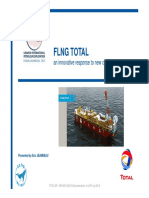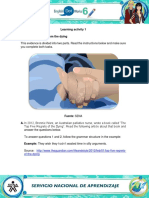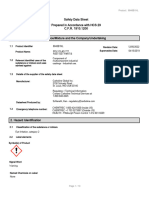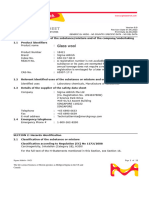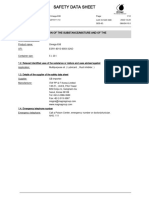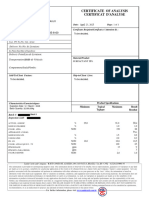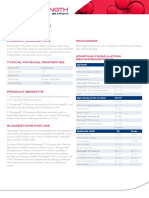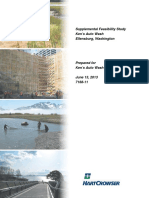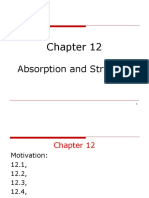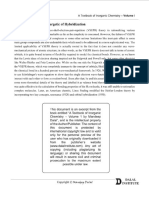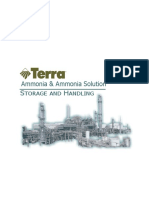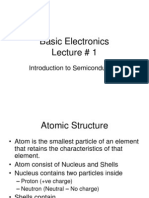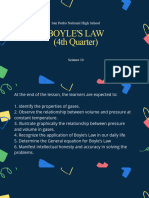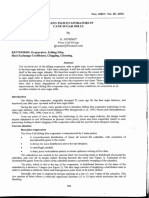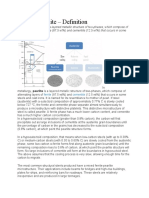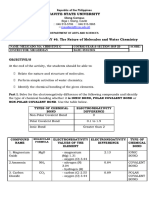Plastistrength® 551 - SDS
Plastistrength® 551 - SDS
Uploaded by
fredCopyright:
Available Formats
Plastistrength® 551 - SDS
Plastistrength® 551 - SDS
Uploaded by
fredCopyright
Available Formats
Share this document
Did you find this document useful?
Is this content inappropriate?
Copyright:
Available Formats
Plastistrength® 551 - SDS
Plastistrength® 551 - SDS
Uploaded by
fredCopyright:
Available Formats
SAFETY DATA SHEET
PLASTISTRENGTH® 551 NA
1. PRODUCT AND COMPANY IDENTIFICATION
Company
Arkema Inc.
900 First Avenue
King of Prussia, Pennsylvania 19406
Arkema Coating Resins
Customer Service Telephone Number: (877) 331-6696
(Monday through Friday, 8:00 AM to 5:00 PM EST)
Emergency Information
Transportation: CHEMTREC: (800) 424-9300
(24 hrs., 7 days a week)
Medical: Rocky Mountain Poison Center: (866) 767-5089
(24 hrs., 7 days a week)
Product Information
Product name: PLASTISTRENGTH® 551 NA
Synonyms: Not available
Molecular formula: Complex mixture
Chemical family: acrylic polymer
Product use: Process aid
2. HAZARDS IDENTIFICATION
Emergency Overview
Color: white
Physical state: solid
Form: powder
Odor: none
*Classification of the substance or mixture:
See Supplemental Hazard Statements below.
GHS-Labelling
Signal word: Warning
Hazard statements:
This material is considered hazardous under the OSHA Hazard Communication Standard criteria, based on
hazard(s) not otherwise classified.
Supplemental Hazard Statements:
Product code: VMQ00 Version 3.6 Issued on: 01/15/2019 Page: 1 / 13
Page 1/14
Quick-FDS [19372-72981-07895-014068] - 2021-01-13 - 20:16:21
SAFETY DATA SHEET
PLASTISTRENGTH® 551 NA
May form combustible dust concentrations in air.
Processing may release vapors and/or fumes which cause eye, skin and respiratory tract irritation.
Supplemental information:
Potential Health Effects:
The product, in the form supplied, is not anticipated to produce significant adverse human health effects.
Contains high molecular weight polymer(s). Effects due to processing releases: Irritating to eyes, respiratory
system and skin. Possible cross sensitization with other acrylates and methacrylates.
Prolonged or repeated exposure may cause: headache, drowsiness, nausea, weakness, (severity of effects
depends on extent of exposure).
Other:
Handle in accordance with good industrial hygiene and safety practice. (powder) Mechanical irritation effects
from dust exposure are possible at ambient temperature. This product may release fume and/or vapor of variable
composition depending on processing time and temperature.
3. COMPOSITION/INFORMATION ON INGREDIENTS
Chemical Name CAS-No. Wt/Wt GHS Classification**
Proprietary acrylic polymer Proprietary* <= 100 % Not classified
Proprietary component H302, H315, H318, H335,
Proprietary* <2%
H412
Water 7732-18-5 <= 1.2 % Not classified
Proprietary constituent Proprietary* <= 0.3 % H400, H411
*The specific chemical identity is withheld because it is trade secret information of Arkema Inc.
Product code: VMQ00 Version 3.6 Issued on: 01/15/2019 Page: 2 / 13
Page 2/14
Quick-FDS [19372-72981-07895-014068] - 2021-01-13 - 20:16:21
SAFETY DATA SHEET
PLASTISTRENGTH® 551 NA
**For the full text of the H-Statements mentioned in this Section, see Section 16.
4. FIRST AID MEASURES
4.1. Description of necessary first-aid measures:
Inhalation:
If inhaled, remove victim to fresh air.
Skin:
In case of contact, immediately flush skin with plenty of water. If molten polymer gets on the skin, cool rapidly with
cold water. Do not peel solidified product off the skin. Obtain medical treatment for thermal burns. Remove material
from clothing. Wash clothing before reuse. Thoroughly clean shoes before reuse.
Eyes:
Immediately flush eye(s) with plenty of water. Obtain medical treatment for thermal burns.
Ingestion:
If swallowed, DO NOT induce vomiting. Get medical attention. Never give anything by mouth to an unconscious
person.
4.2. Most important symptoms/effects, acute and delayed:
For most important symptoms and effects (acute and delayed), see Section 2 (Hazard Statements and Supplemental
Information if applicable) and Section 11 (Toxicology Information) of this SDS.
4.3. Indication of immediate medical attention and special treatment needed, if necessary:
Unless otherwise noted in Notes to Physician, no specific treatment noted; treat symptomatically.
5. FIREFIGHTING MEASURES
Extinguishing media (suitable):
Water spray
Extinguishing media (unsuitable):
High volume water jet
Protective equipment:
Fire fighters and others who may be exposed to products of combustion should wear full fire fighting turn out gear
(full Bunker Gear) and self-contained breathing apparatus (pressure demand / NIOSH approved or equivalent).
Further firefighting advice:
Do not use a solid stream of water.
A solid stream of water can cause a dust explosion.
Fire fighting equipment should be thoroughly decontaminated after use.
Fire and explosion hazards:
Product code: VMQ00 Version 3.6 Issued on: 01/15/2019 Page: 3 / 13
Page 3/14
Quick-FDS [19372-72981-07895-014068] - 2021-01-13 - 20:16:21
SAFETY DATA SHEET
PLASTISTRENGTH® 551 NA
Dust clouds generated during handling and/or storage can form explosive mixtures with air. Dust explosion
characteristics vary with the particle size, particle shape, moisture content, contaminants, and other variables.
Note: Check that all equipment is properly grounded and installed to satisfy electrical classification requirements. As
with any dry material, pouring this material or allowing it to free-fall or to be conveyed through chutes or pipes can
accumulate and generate electrostatic sparks, potentially causing ignition of the material itself, or of any flammable
materials which may come into contact with the material or its container.
When burned, the following hazardous products of combustion can occur:
Carbon oxides
Hazardous organic compounds
sulfur oxides
6. ACCIDENTAL RELEASE MEASURES
Personal precautions, Emergency procedures, Methods and materials for containment/clean-up:
Prevent further leakage or spillage if you can do so without risk. Evacuate area of all unnecessary personnel.
Ventilate the area. Eliminate all ignition sources. Avoid dust formation and dispersal of dust in the air. Wet down
(dampen) the spilled material with water. Sweep or scoop up using non-sparking tools and place into suitable
properly labeled containers for prompt disposal. The sweepings should be wetted down further with water. Avoid
dispersal of spilled material and runoff and contact with soil, waterways, drains and sewers. Implement workplace
practices such that dusts are not allowed to accumulate on surfaces, as these may form an explosive mixture if they
are released into the atmosphere in sufficient concentration. Consult a regulatory specialist to determine appropriate
state or local reporting requirements, for assistance in waste characterization and/or hazardous waste disposal and
other requirements listed in pertinent environmental permits.
Protective equipment:
Appropriate personal protective equipment is set forth in Section 8.
7. HANDLING AND STORAGE
Handling
General information on handling:
Avoid breathing dust.
Avoid breathing processing fumes or vapors.
Keep away from heat, sparks and flames.
Keep container closed.
Avoid creating dust in handling, transfer or clean up.
Prevent dust accumulation.
Implement routine housekeeping practices to ensure that dusts do not accumulate on surfaces.
Check that all equipment is properly grounded and installed to satisfy electrical classification requirements.
Dry powders can build static electricity charges when subjected to the friction of transfer and mixing operations.
Container hazardous when empty.
Follow label warnings even after container is emptied.
RESIDUAL DUSTS MAY EXPLODE ON IGNITION.
DO NOT CUT, DRILL, GRIND, OR WELD ON OR NEAR THIS CONTAINER.
Improper disposal or reuse of this container may be dangerous and/or illegal.
Emptied container retains product residue.
Handle in accordance with good industrial hygiene and safety practices. These practices include avoiding
unnecessary exposure and removal of material from eyes, skin, and clothing.
Product code: VMQ00 Version 3.6 Issued on: 01/15/2019 Page: 4 / 13
Page 4/14
Quick-FDS [19372-72981-07895-014068] - 2021-01-13 - 20:16:21
SAFETY DATA SHEET
PLASTISTRENGTH® 551 NA
Storage
General information on storage conditions:
Keep in a dry, cool place.Store in closed containers, in a secure area to prevent container damage and subsequent
spillage.Store in well ventilated area away from heat and sources of ignition such as flame, sparks and static
electricity.Ensure that all storage and handling equipment is properly grounded and installed to satisfy electrical
classification requirements.Static electricity may accumulate when transferring material.All metal and groundable
storage containers, including but not limited to drums, cylinders, Returnable Intermodal Bulk Containers (RIBCs)
and Class C Flexible Intermodal Bulk Containers (FIBCs) must be bonded and grounded during filling and emptying
operations.Observe all federal, state and local regulations and National Fire Protection Association (NFPA) Codes,
which pertain to the specific local conditions of storage and use, including NFPA 654.
Storage stability – Remarks:
Stable under recommended storage conditions.
Storage incompatibility – General:
Store separate from:
Reducing agents
Strong bases
8. EXPOSURE CONTROLS/PERSONAL PROTECTION
Airborne Exposure Guidelines:
Particles Not Otherwise Specified / Nuisance Dust (Proprietary)
US. ACGIH Threshold Limit Values
Form: Inhalable particles.
Time weighted average 10 mg/m3
Form: Respirable particles.
Time weighted average 3 mg/m3
US. OSHA Table Z-1 Limits for Air Contaminants (29 CFR 1910.1000)
Form: Respirable fraction.
PEL: 5 mg/m3
US. OSHA Table Z-1 Limits for Air Contaminants (29 CFR 1910.1000)
Form: Total dust
PEL: 15 mg/m3
US. OSHA Table Z-3 (29 CFR 1910.1000)
Form: Respirable fraction.
Time weighted average 15millions of particles per cubic foot of air
US. OSHA Table Z-3 (29 CFR 1910.1000)
Form: Total dust
Product code: VMQ00 Version 3.6 Issued on: 01/15/2019 Page: 5 / 13
Page 5/14
Quick-FDS [19372-72981-07895-014068] - 2021-01-13 - 20:16:21
SAFETY DATA SHEET
PLASTISTRENGTH® 551 NA
Time weighted average 50millions of particles per cubic foot of air
US. OSHA Table Z-3 (29 CFR 1910.1000)
Form: Respirable fraction.
Time weighted average 5 mg/m3
US. OSHA Table Z-3 (29 CFR 1910.1000)
Form: Total dust
Time weighted average 15 mg/m3
Only those components with exposure limits are printed in this section. Limits with skin contact designation above have skin contact
effect. Air sampling alone is insufficient to accurately quantitate exposure. Measures to prevent significant cutaneous absorption
may be required. Limits with a sensitizer designation above mean that exposure to this material may cause allergic reactions.
Engineering controls:
Investigate engineering techniques to reduce exposures below airborne exposure limits or to otherwise reduce
exposures. Provide ventilation if necessary to minimize exposures or to control exposure levels to below
airborne exposure limits (if applicable see above).If practical, use local mechanical exhaust ventilation at
sources of air contamination such as open process equipment.
Check that all dust control equipment such as local exhaust ventilation, material transport systems, and air-
material separation devices involved in handling this product contain explosion relief vents or an explosion
suppression system or an oxygen-deficient environment.Isolation devices may be appropriate to prevent
propagation from one unit to another.Ensure that dust-handling systems are designed in a manner to prevent
the escape of dust into the work area (i.e., there is no leakage from the equipment).Consult ACGIH ventilation
manual, NFPA Standard 91 and NFPA Standard 654 for design of exhaust system and safe handling.
Respiratory protection:
Avoid breathing dust. Avoid breathing processing fumes or vapors. Where airborne exposure is likely or
airborne exposure limits are exceeded (if applicable, see above), use NIOSH approved respiratory protection
equipment appropriate to the material and/or its components and substances released during processing.
Consult respirator manufacturer to determine appropriate type equipment for a given application. Observe
respirator use limitations specified by NIOSH or the manufacturer. For emergency and other conditions where
there may be a potential for significant exposure or where exposure limit may be significantly exceeded, use an
approved full face positive-pressure, self-contained breathing apparatus or positive-pressure airline with
auxiliary self-contained air supply. Respiratory protection programs must comply with 29 CFR § 1910.134.
Skin protection:
Processing of this product releases vapors or fumes which may cause skin irritation. Minimize skin
contamination by following good industrial hygiene practice. Wearing protective gloves is recommended. Wash
hands and contaminated skin thoroughly after contact with processing fumes or vapors. Wash thoroughly after
handling.
Product code: VMQ00 Version 3.6 Issued on: 01/15/2019 Page: 6 / 13
Page 6/14
Quick-FDS [19372-72981-07895-014068] - 2021-01-13 - 20:16:21
SAFETY DATA SHEET
PLASTISTRENGTH® 551 NA
Eye protection:
Use good industrial practice to avoid eye contact. Processing of this product releases vapors or fumes which
may cause eye irritation. Where eye contact may be likely, wear chemical goggles and have eye flushing
equipment available.
9. PHYSICAL AND CHEMICAL PROPERTIES
Color: white
Physical state: solid
Form: powder
Odor: none
Odor threshold: No data available
Flash point Not applicable
Auto-ignition 878 °F (470 °C)
temperature:
Lower flammable limit Not applicable
(LFL):
Upper flammable limit Not applicable
(UFL):
pH: Not applicable
Density: 1.17 g/cm3
Specific Gravity (Relative No data available
density):
Boiling point/boiling Not applicable
range:
Melting point/range: No data available
Freezing point: Not applicable
Evaporation rate: No data available
Solubility in water: insoluble
Viscosity, dynamic: No data available
Oil/water partition No data available.
coefficient:
Thermal decomposition: No data available
Product code: VMQ00 Version 3.6 Issued on: 01/15/2019 Page: 7 / 13
Page 7/14
Quick-FDS [19372-72981-07895-014068] - 2021-01-13 - 20:16:21
SAFETY DATA SHEET
PLASTISTRENGTH® 551 NA
Flammability: See GHS Classification in Section 2 if applicable
10. STABILITY AND REACTIVITY
Stability:
The product is stable under normal handling and storage conditions.
Hazardous reactions:
Hazardous polymerization does not occur.
Materials to avoid:
Strong bases
Reducing agents
Conditions / hazards to avoid:
See HANDLING AND STORAGE section of this MSDS for specified conditions. See Hazardous Decomposition
Products below.
Hazardous decomposition products:
Thermal decomposition giving flammable and toxic products :
Carbon oxides
Hazardous organic compounds
Acrylates
Methacrylates
sulfur oxides
11. TOXICOLOGICAL INFORMATION
Data on this material and/or a similar material are summarized below.
Data for PLASTISTRENGTH® 551 NA
Acute toxicity
Oral:
Acute toxicity estimate > 5,000 mg/kg.
Eye Irritation:
Causes mild eye irritation. (rabbit) (data for a similar material)
Data for Proprietary acrylic polymer (Proprietary)
Other information
The information presented is from representative materials in this chemical class. The results may vary
depending on the test substance.
Effects due to processing releases or residual monomer:
Possible cross sensitization with other acrylates and methacrylates.
Data for Proprietary component (Proprietary)
Acute toxicity
Product code: VMQ00 Version 3.6 Issued on: 01/15/2019 Page: 8 / 13
Page 8/14
Quick-FDS [19372-72981-07895-014068] - 2021-01-13 - 20:16:21
SAFETY DATA SHEET
PLASTISTRENGTH® 551 NA
Oral:
Harmful if swallowed. (rat) LD50 = 1,200 mg/kg.
Dermal:
No deaths occurred. (rabbit) LD0 > 2,000 mg/kg. (data for a similar material)
Specific target organ toxicity - single exposure:
May cause respiratory irritation.
Skin Irritation:
Causes skin irritation. (rabbit) (24 h)
Eye Irritation:
Causes serious eye damage. (rabbit)
Skin Sensitization:
Not a sensitizer. LLNA: Local Lymph Node Assay. (mouse) No skin allergy was observed
Not a sensitizer. Guinea pig maximization test. No skin allergy was observed
Repeated dose toxicity
Subchronic dietary administration to rat / No adverse systemic effects reported.
Repeated dermal administration to rat / signs: Local irritation, ulceration
Carcinogenicity
Chronic dietary administration to rat / No increase in tumor incidence was reported.
Genotoxicity
Assessment in Vitro:
No genetic changes were observed in laboratory tests using: bacteria, animal cells
Genotoxicity
Assessment in Vivo:
No genetic changes were observed in laboratory tests using: rat, mice
Other information
The information presented is from representative materials in this chemical class. The results may vary
depending on the test substance.
12. ECOLOGICAL INFORMATION
Chemical Fate and Pathway
Data on this material and/or its components are summarized below.
Data for Proprietary component (Proprietary)
Biodegradation:
Readily biodegradable. (28 d) biodegradation 95 %
Product code: VMQ00 Version 3.6 Issued on: 01/15/2019 Page: 9 / 13
Page 9/14
Quick-FDS [19372-72981-07895-014068] - 2021-01-13 - 20:16:21
SAFETY DATA SHEET
PLASTISTRENGTH® 551 NA
Octanol Water Partition Coefficient:
log Pow: = 0.8 - 1.6
Additional Information:
The information presented is from representative materials in this chemical class. The results may vary
depending on the test substance.
Data for Proprietary constituent (Proprietary)
Biodegradation:
Readily biodegradable. (28 d) biodegradation 80 %
Octanol Water Partition Coefficient:
log Pow: = 4.6 - 6.4
Additional Information:
The information presented is from representative materials in this chemical class. The results may vary
depending on the test substance.
Ecotoxicology
Data on this material and/or its components are summarized below.
Data for Proprietary component (Proprietary)
The information presented is from representative materials in this chemical class. The results may vary
depending on the test substance.
Aquatic toxicity data:
Harmful. Pimephales promelas (fathead minnow) 96 h LC50 = 29 mg/l
Aquatic invertebrates:
Toxic. Ceriodaphnia dubia 48 h LC50 = 5.55 mg/l
Algae:
Practically nontoxic. Desmodesmus subspicatus (green algae) 72 h EC50 > 120 mg/l
Microorganisms:
Respiration inhibition of activated sludge / Activated sludge 3 h EC50 = 135 mg/l
Data for Proprietary constituent (Proprietary)
The information presented is from representative materials with this Chemical Abstract Service (CAS) Registry
number. The results vary depending on the size and composition of the test substance.
Aquatic toxicity data:
Toxic. Salmo gairdneri 96 h LC50 = 4 mg/l
Aquatic invertebrates:
Very toxic. Daphnia magna (Water flea) 48 h EL50 = 0.23 mg/l
Algae:
Very toxic. Selenastrum capricornutum 72 h ErL50 = 0.44 mg/l
Product code: VMQ00 Version 3.6 Issued on: 01/15/2019 Page: 10 / 13
Page 10/14
Quick-FDS [19372-72981-07895-014068] - 2021-01-13 - 20:16:21
SAFETY DATA SHEET
PLASTISTRENGTH® 551 NA
13. DISPOSAL CONSIDERATIONS
Waste disposal:
Where possible recycling is preferred to disposal or incineration. If recycling is not an option, incinerate or dispose of
in accordance with federal, state, and local regulations. Pigmented, filled and/or solvent laden product may require
special disposal practices in accordance with federal, state and local regulations. Consult a regulatory specialist to
determine appropriate state or local reporting requirements, for assistance in waste characterization and/or
hazardous waste disposal and other requirements listed in pertinent environmental permits. Note: Chemical
additions to, processing of, or otherwise altering this material may make this waste management information
incomplete, inaccurate, or otherwise inappropriate. Furthermore, state and local waste disposal requirements may
be more restrictive or otherwise different from federal laws and regulations.
14. TRANSPORT INFORMATION
US Department of Transportation (DOT): not regulated
International Maritime Dangerous Goods Code (IMDG): not regulated
15. REGULATORY INFORMATION
Chemical Inventory Status
US. Toxic Substances Control Act TSCA The components of this product are all on
the TSCA Inventory.
Canadian Domestic Substances List (DSL) DSL All components of this product are on the
Canadian DSL
China. Inventory of Existing Chemical Substances in IECSC (CN) Conforms to
China (IECSC)
Japan. ENCS - Existing and New Chemical ENCS (JP) Does not conform
Substances Inventory
Japan. ISHL - Inventory of Chemical Substances ISHL (JP) Does not conform
Korea. Korean Existing Chemicals Inventory (KECI) KECI (KR) Conforms to
Philippines Inventory of Chemicals and Chemical PICCS (PH) Conforms to
Substances (PICCS)
Australia Inventory of Chemical Substances (AICS) AICS Conforms to
United States – Federal Regulations
SARA Title III – Section 302 Extremely Hazardous Chemicals:
The components in this product are either not SARA Section 302 regulated or regulated but present in negligible
concentrations.
Product code: VMQ00 Version 3.6 Issued on: 01/15/2019 Page: 11 / 13
Page 11/14
Quick-FDS [19372-72981-07895-014068] - 2021-01-13 - 20:16:21
SAFETY DATA SHEET
PLASTISTRENGTH® 551 NA
SARA Title III - Section 311/312 Hazard Categories:
Fire Hazard
SARA Title III – Section 313 Toxic Chemicals:
This material does not contain any chemical components with known CAS numbers that exceed the
threshold (De Minimis) reporting levels established by SARA Title III, Section 313.
Comprehensive Environmental Response, Compensation, and Liability Act (CERCLA) - Reportable
Quantity (RQ):
The components in this product are either not CERCLA regulated, regulated but present in negligible
concentrations, or regulated with no assigned reportable quantity.
United States – State Regulations
New Jersey Right to Know
No components are subject to the New Jersey Right to Know Act.
Pennsylvania Right to Know
Chemical name CAS-No.
Proprietary acrylic polymer Proprietary
California Prop. 65
This product does not contain any chemicals known to the State of California to cause cancer, birth
defects, or any other reproductive defects.
16. OTHER INFORMATION
Full text of H-Statements referred to under sections 2 and 3.
H302 Harmful if swallowed.
H315 Causes skin irritation.
H318 Causes serious eye damage.
H335 May cause respiratory irritation.
H400 Very toxic to aquatic life.
H411 Toxic to aquatic life with long lasting effects.
H412 Harmful to aquatic life with long lasting effects.
Miscellaneous:
Other information: Refer to National Fire Protection Association (NFPA) Code 654,
Standard for the Prevention of Fire and Dust Explosions from the
Manufacturing, Processing, and Handling of Combustible Particulate
Solids, for safe handling.
Latest Revision(s):
Reference number: 200009460
Date of Revision: 01/15/2019
Date Printed: 01/15/2019
Product code: VMQ00 Version 3.6 Issued on: 01/15/2019 Page: 12 / 13
Page 12/14
Quick-FDS [19372-72981-07895-014068] - 2021-01-13 - 20:16:21
SAFETY DATA SHEET
PLASTISTRENGTH® 551 NA
PLASTISTRENGTH® is a registered trademark of Arkema Inc.
The statements, technical information and recommendations contained herein are believed to be accurate as of the date hereof.
Since the conditions and methods of use of the product and of the information referred to herein are beyond our control, ARKEMA
expressly disclaims any and all liability as to any results obtained or arising from any use of the product or reliance on such
information; NO WARRANTY OF FITNESS FOR ANY PARTICULAR PURPOSE, WARRANTY OF MERCHANTABILITY OR ANY
OTHER WARRANTY, EXPRESSED OR IMPLIED, IS MADE CONCERNING THE GOODS DESCRIBED OR THE INFORMATION
PROVIDED HEREIN. The information provided herein relates only to the specific product designated and may not be applicable
when such product is used in combination with other materials or in any process. The user should thoroughly test any application
before commercialization. Nothing contained herein constitutes a license to practice under any patent and it should not be
construed as an inducement to infringe any patent and the user is advised to take appropriate steps to be sure that any proposed
use of the product will not result in patent infringement. See SDS for Health & Safety Considerations.
Arkema has implemented a Medical Policy regarding the use of Arkema products in Medical Devices applications that are in contact
with the body or circulating bodily fluids (http://www.arkema.com/en/social-responsibility/responsible-product-management/medical-
device-policy/index.html) Arkema has designated Medical grades to be used for such Medical Device applications. Products that
have not been designated as Medical grades are not authorized by Arkema for use in Medical Device applications that are in
contact with the body or circulating bodily fluids. In addition, Arkema strictly prohibits the use of any Arkema products in Medical
Device applications that are implanted in the body or in contact with bodily fluids or tissues for greater than 30 days. The Arkema
trademarks and the Arkema name shall not be used in conjunction with customers' medical devices, including without limitation,
permanent or temporary implantable devices , and customers shall not represent to anyone else, that Arkema allows, endorses or
permits the use of Arkema products in such medical devices.
It is the sole responsibility of the manufacturer of the medical device to determine the suitability (including biocompatibility) of all raw
materials, products and components, including any medical grade Arkema products, in order to ensure that the final end-use
product is safe for its end use; performs or functions as intended; and complies with all applicable legal and regulatory requirements
(FDA or other national drug agencies) It is the sole responsibility of the manufacturer of the medical device to conduct all necessary
tests and inspections and to evaluate the medical device under actual end-use requirements and to adequately advise and warn
purchasers, users, and/or learned intermediaries (such as physicians) of pertinent risks and fulfill any postmarket surveillance
obligations. Any decision regarding the appropriateness of a particular Arkema material in a particular medical device should be
based on the judgment of the manufacturer, seller, the competent authority, and the treating physician.
Product code: VMQ00 Version 3.6 Issued on: 01/15/2019 Page: 13 / 13
Page 13/14
Quick-FDS [19372-72981-07895-014068] - 2021-01-13 - 20:16:21
Page 14/14
Quick-FDS [19372-72981-07895-014068] - 2021-01-13 - 20:16:21
You might also like
- 5250-4rtm Structural Prepreg English SdsDocument11 pages5250-4rtm Structural Prepreg English Sdsanacarol09No ratings yet
- Nivxmffnöi L) Abaña Nivxmffnöi L) Abaña: FLA-X@-VVR-NI-886 FLA-X@-VVR-NI-886Document1 pageNivxmffnöi L) Abaña Nivxmffnöi L) Abaña: FLA-X@-VVR-NI-886 FLA-X@-VVR-NI-886Juan Sebastián Melo AriasNo ratings yet
- Material Safety Data Sheet: - ElitoxDocument2 pagesMaterial Safety Data Sheet: - ElitoxJayusAliRahman100% (2)
- Plastistrength® 562 - SDSDocument14 pagesPlastistrength® 562 - SDSfredNo ratings yet
- Plastistrength® 562 - SDSDocument14 pagesPlastistrength® 562 - SDSfredNo ratings yet
- Total - FLNG TechnologyDocument14 pagesTotal - FLNG TechnologyRagerishcire KanaalaqNo ratings yet
- Biospada Plus 60 Technical Data Sheet - CopiarDocument2 pagesBiospada Plus 60 Technical Data Sheet - CopiarPablo CuellarNo ratings yet
- Producto 3: A Country ProfileDocument2 pagesProducto 3: A Country ProfileLaura DomínguezNo ratings yet
- Learning Activity 1 Evidence: Regrets From The DyingDocument5 pagesLearning Activity 1 Evidence: Regrets From The DyingZabdi SuarezNo ratings yet
- Premi Test Instruc For UseDocument1 pagePremi Test Instruc For UseVeronica Drg100% (2)
- Unidad 3 Actividad 1 - Informe Escrito (Idioma Inglés)Document5 pagesUnidad 3 Actividad 1 - Informe Escrito (Idioma Inglés)Valentina LedesmaNo ratings yet
- Rutina para Supervisor de OperacionesDocument8 pagesRutina para Supervisor de OperacionesRoss Mabel Ojeda de GarayNo ratings yet
- Presentación Rutina Diaria. AA1-EV03.Document11 pagesPresentación Rutina Diaria. AA1-EV03.David SilvaNo ratings yet
- LD 4 MSDSDocument19 pagesLD 4 MSDSKevin John P. PangilinanNo ratings yet
- Plastistrength® 550 - SDSDocument14 pagesPlastistrength® 550 - SDSfredNo ratings yet
- SDS, V-Grade Acrylic - From IPSDocument10 pagesSDS, V-Grade Acrylic - From IPSVio AmarieiNo ratings yet
- PD - 1136 (1159) ® - SDSDocument14 pagesPD - 1136 (1159) ® - SDSfredNo ratings yet
- 8848B1NL 2 UsansiDocument10 pages8848B1NL 2 UsansiSivaramkumarNo ratings yet
- Encor 8460 MSDSDocument12 pagesEncor 8460 MSDSJin AllenNo ratings yet
- Plexiglas® V825-100 Acrylic Resin: Material Safety Data SheetDocument9 pagesPlexiglas® V825-100 Acrylic Resin: Material Safety Data SheetLeandro LacerdaNo ratings yet
- Safety Data Sheet Prepared in Accordance With HCS 29 C.F.R. 1910.1200Document9 pagesSafety Data Sheet Prepared in Accordance With HCS 29 C.F.R. 1910.1200Ayman ElMawardyNo ratings yet
- 3M Scotchcast 2131Document45 pages3M Scotchcast 2131empmedicNo ratings yet
- Ethyl acetate-MSDSDocument13 pagesEthyl acetate-MSDS張楷泓No ratings yet
- Safety Data Sheet: Glass WoolDocument11 pagesSafety Data Sheet: Glass WoolIqbal Muhamad FarizNo ratings yet
- ea375e02-e2b7-4568-a204-c1c6a9dee657Document10 pagesea375e02-e2b7-4568-a204-c1c6a9dee657kougunyouNo ratings yet
- Alpha Ketoglutaric AcidDocument9 pagesAlpha Ketoglutaric AcidSNo ratings yet
- Decolorizer SDSDocument10 pagesDecolorizer SDSKike PadillaNo ratings yet
- 3M Scotchcast Re-Enterable Electrical InsulatingDocument26 pages3M Scotchcast Re-Enterable Electrical InsulatingPLN UPT MAKASSARNo ratings yet
- Safety Data Sheet: Oxalic AcidDocument11 pagesSafety Data Sheet: Oxalic Acidmanav mistryNo ratings yet
- Msds (3-Aminopropyl) Trimethoxysilane ENDocument9 pagesMsds (3-Aminopropyl) Trimethoxysilane ENClaudio BiaginiNo ratings yet
- Safety Data Sheet: CaffeineDocument9 pagesSafety Data Sheet: CaffeinenovinskaNo ratings yet
- Omega 638 - GB - EN - 10.0 - 12 - 20 - 2022Document12 pagesOmega 638 - GB - EN - 10.0 - 12 - 20 - 2022ckpangNo ratings yet
- Safety Data Sheet: (+) - Methamphetamine HydrochlorideDocument11 pagesSafety Data Sheet: (+) - Methamphetamine HydrochlorideElvis YuNo ratings yet
- SDS Ethyl AcetateDocument13 pagesSDS Ethyl AcetateHARNITH EVILLNo ratings yet
- AcetoneDocument11 pagesAcetoneshuvo.shahaNo ratings yet
- MSDS - PS 180 MDocument9 pagesMSDS - PS 180 MJahangeer KhanNo ratings yet
- Safety Data Sheet Prepared To UN GHS Revision 3: Date Printed: 25/06/2018 Product: 520 CLEARDocument8 pagesSafety Data Sheet Prepared To UN GHS Revision 3: Date Printed: 25/06/2018 Product: 520 CLEARKOKOLENo ratings yet
- Dowfroth 250Document13 pagesDowfroth 250asesoresmtc05No ratings yet
- MSDS - 23344163 - Desy HaryantiDocument9 pagesMSDS - 23344163 - Desy Haryantiwulan.apritasariNo ratings yet
- Safety Data Sheet: Sodium CarbonateDocument9 pagesSafety Data Sheet: Sodium Carbonateκ.μ.α «— Brakat»No ratings yet
- Safety Data Sheet: 2,2,2-TribromoethanolDocument11 pagesSafety Data Sheet: 2,2,2-TribromoethanolkokoNo ratings yet
- 2 PentanolDocument12 pages2 Pentanoljalal.mNo ratings yet
- Msds (3-Glycidyloxypropyl) Trimethoxysilane ENDocument9 pagesMsds (3-Glycidyloxypropyl) Trimethoxysilane ENClaudio BiaginiNo ratings yet
- Ficha Seguridad EnvioDocument12 pagesFicha Seguridad Envioabedrop98No ratings yet
- Boric Acid - SigmaDocument10 pagesBoric Acid - SigmaZeba PiquieNo ratings yet
- Calcium Nitrate SDS EU enDocument11 pagesCalcium Nitrate SDS EU enAxumawi HalilemichalNo ratings yet
- Safety Data Sheet: DichloromethaneDocument12 pagesSafety Data Sheet: DichloromethanewidyaNo ratings yet
- Metronidazole Tablets 13 Apr 2018Document11 pagesMetronidazole Tablets 13 Apr 2018Nanda Akbar WibisonoNo ratings yet
- Sigma-Aldrich: EthanolDocument8 pagesSigma-Aldrich: Ethanolalifia hajar amandaNo ratings yet
- Spotleak 1001 MsdsDocument14 pagesSpotleak 1001 MsdsMohd RafiNo ratings yet
- IbuprofenDocument11 pagesIbuprofenNakkiran ArulmozhiNo ratings yet
- Safety Data Sheet: ( ) - Ethyl L-LactateDocument9 pagesSafety Data Sheet: ( ) - Ethyl L-LactateClaudio BiaginiNo ratings yet
- 1611731551_UNITED XD 9000S SAE 15W-40 API CH4 SJ - sds (E) 5156Document9 pages1611731551_UNITED XD 9000S SAE 15W-40 API CH4 SJ - sds (E) 5156thangbom999No ratings yet
- CTC ConcentrateDocument7 pagesCTC ConcentrateDharmender MaanNo ratings yet
- MSDS-Methyl Orange - CAS 547-58-0Document9 pagesMSDS-Methyl Orange - CAS 547-58-0Oscar BenimanaNo ratings yet
- Diasen D20 Material Safety Datasheet_1_14-02-2020Document9 pagesDiasen D20 Material Safety Datasheet_1_14-02-2020thaparabin1221No ratings yet
- MegaCleanActive SDSDocument7 pagesMegaCleanActive SDSEdgar Uriel Castillejos DíazNo ratings yet
- ADI-145 Microvit K3 Promix MNB 96 (en-US)Document10 pagesADI-145 Microvit K3 Promix MNB 96 (en-US)sofia baldiviesoNo ratings yet
- M0BIL254QT 3Z US EN safetyDataSheet Sds 8799831064580 0 1Document10 pagesM0BIL254QT 3Z US EN safetyDataSheet Sds 8799831064580 0 1AEROREPARACION LTDANo ratings yet
- SDS Magnesium Chloride - RM - 2024Document11 pagesSDS Magnesium Chloride - RM - 2024nursyammauludi.mnmNo ratings yet
- Print MSDSActionDocument7 pagesPrint MSDSActionERNICHE GUEVARANo ratings yet
- 1 2 4 Trichlorobenzene SDSDocument7 pages1 2 4 Trichlorobenzene SDSMali teaNo ratings yet
- Zanini, Curtis & Company - August 2022Document27 pagesZanini, Curtis & Company - August 2022fredNo ratings yet
- Crystex HD Ot 20 PDS EastmanDocument2 pagesCrystex HD Ot 20 PDS EastmanfredNo ratings yet
- MSDS - Sulfochem (TM) TD-3 PHP SurfactantDocument11 pagesMSDS - Sulfochem (TM) TD-3 PHP SurfactantfredNo ratings yet
- Stockosorb 660 - PTDocument2 pagesStockosorb 660 - PTfredNo ratings yet
- Coa - Surfact 30 - ZaniniDocument1 pageCoa - Surfact 30 - ZaninifredNo ratings yet
- Plastistrength® 550 - SDSDocument14 pagesPlastistrength® 550 - SDSfredNo ratings yet
- Plastistrength® 551 - TDSDocument2 pagesPlastistrength® 551 - TDSfredNo ratings yet
- Plastistrength® 550 - TDSDocument2 pagesPlastistrength® 550 - TDSfredNo ratings yet
- PD - 1136 (1159) ® - SDSDocument14 pagesPD - 1136 (1159) ® - SDSfredNo ratings yet
- Durastrength® 200 - TDSDocument3 pagesDurastrength® 200 - TDSfredNo ratings yet
- Final Supplemental FSDocument42 pagesFinal Supplemental FSJemairen DelpuertoNo ratings yet
- Ballot Cover Page: Api RP 581 - Risk Based Inspection Base Resource DocumentDocument15 pagesBallot Cover Page: Api RP 581 - Risk Based Inspection Base Resource DocumentAfiq IkhwanNo ratings yet
- Conversion Denier To MicronDocument6 pagesConversion Denier To Microncwqccq100% (1)
- Chapt 12Document40 pagesChapt 12ShamsMohdNo ratings yet
- ATOICV1 1 3 Bent Rule and Energetic of Hybridization PDFDocument21 pagesATOICV1 1 3 Bent Rule and Energetic of Hybridization PDFAmala Rose BabychanNo ratings yet
- Chemistry Pre Board Exam Paper Class 12th.Document7 pagesChemistry Pre Board Exam Paper Class 12th.Hello HiNo ratings yet
- Ammonia & Ammonia Solution STORAGE AND HANDLINGDocument28 pagesAmmonia & Ammonia Solution STORAGE AND HANDLINGmah_abdelaalNo ratings yet
- Preconditioner Unit - Temperature - 40C - NAEnglishDocument12 pagesPreconditioner Unit - Temperature - 40C - NAEnglishKartik WadhwaNo ratings yet
- Incomplete CombustionDocument5 pagesIncomplete CombustionDineshkumarNo ratings yet
- Hammett 2015 Turbulence SULI All PDFDocument64 pagesHammett 2015 Turbulence SULI All PDFgwhammettNo ratings yet
- U.S. Bellows 101: Expansion Joint BasicsDocument35 pagesU.S. Bellows 101: Expansion Joint Basicskselvan_1No ratings yet
- Dce 1 Odd Basics Chemistry 2021-22Document10 pagesDce 1 Odd Basics Chemistry 2021-2218TAL011 RITI MONDALNo ratings yet
- Basic Electronics Lecture # 1: Introduction To SemiconductorsDocument46 pagesBasic Electronics Lecture # 1: Introduction To Semiconductorsawais89898967% (3)
- Course Title: First Aid & Water Survival & Life Saving - Charlene B. Agana A.Y. 2021-2022Document19 pagesCourse Title: First Aid & Water Survival & Life Saving - Charlene B. Agana A.Y. 2021-2022jv bhogsNo ratings yet
- SDS Lithium Sulfide EUDocument7 pagesSDS Lithium Sulfide EULuzania Alves Moreira da silvaNo ratings yet
- Process Advancement in Chemistry and Chemical Engineering Research (2015) PDFDocument378 pagesProcess Advancement in Chemistry and Chemical Engineering Research (2015) PDFnico123456789No ratings yet
- Homework-4 - Spring 2021Document1 pageHomework-4 - Spring 2021Ahmet KuralNo ratings yet
- Spectrum Esp ProtectorDocument1 pageSpectrum Esp ProtectorDirector TecnicoNo ratings yet
- DPF Cleaner Agent MSDS 2021Document5 pagesDPF Cleaner Agent MSDS 2021Jorge SepulvedaNo ratings yet
- A New Approach To ThermodynamicsDocument8 pagesA New Approach To ThermodynamicsEyitoyosiNo ratings yet
- ThermoFlex Service ManualDocument90 pagesThermoFlex Service ManualDavide RadaelliNo ratings yet
- Numerical of KP and KCDocument8 pagesNumerical of KP and KCmrymits3No ratings yet
- 4th Quarter Week 1 1Document59 pages4th Quarter Week 1 1Jonathan MayoNo ratings yet
- 2005 Jounet Falling Film Evaporators in Cane Sugar Mills PDFDocument12 pages2005 Jounet Falling Film Evaporators in Cane Sugar Mills PDFnghi100% (1)
- Enzyme LabDocument3 pagesEnzyme LabRicardoNo ratings yet
- Katalog ProdukDocument37 pagesKatalog ProdukfebrinaNo ratings yet
- What Is PearliteDocument4 pagesWhat Is Pearliteardy cornettoNo ratings yet
- Act7 MelicadoDocument5 pagesAct7 MelicadochristinamelicadoNo ratings yet
- Crosslinked and Linear Gel CompositionDocument11 pagesCrosslinked and Linear Gel CompositionrodrigoayresNo ratings yet




